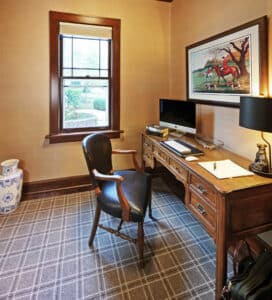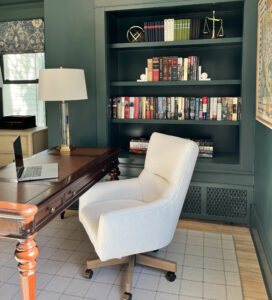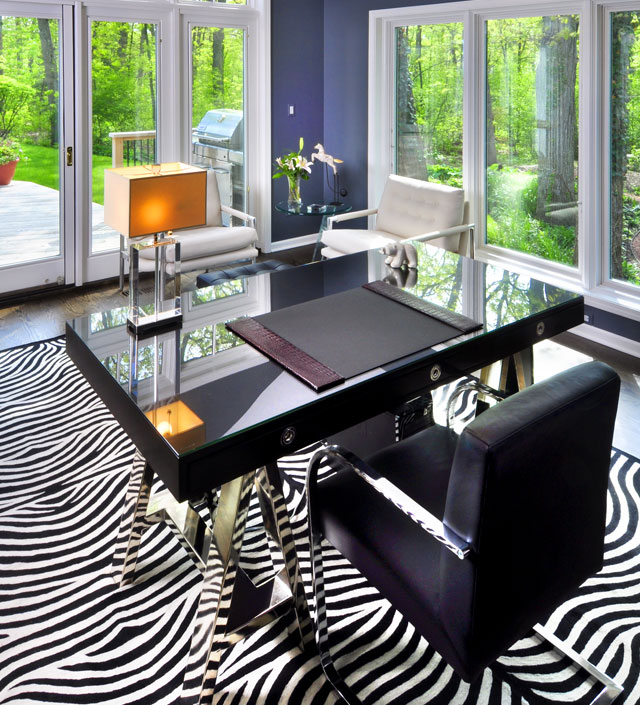Nearly one third (32%) of seniors age 65 to 69 are working, up from less than 25% in 2000, according to a report from the Federal Reserve Bank of Minneapolis. For seniors who need to work for financial reasons or just want to keep their hand in, a home-based business allows for the flexibility and freedom they crave after a long career.
While a lot of people make do with a kitchen counter or a sofa, there’s a lot to be said for having a beautifully designed, dedicated work space.
Home offices are easier to achieve than you might expect. One reason is that we require far less of our home offices today than in the past. Because we do almost all of our work on our computers, our need for storage (for items like paper files) is minimal. Equipment like color printers keeps getting more compact as well.
That said, screen time stresses aging eyes and sitting for long periods takes a toll on older bodies. Home offices that connect to nature through windows and access to the outdoors can actually lead to better productivity. Nature energizes and refreshes.
If you have a client contemplating a post-retirement business, here are some considerations you can offer so they can achieve peace and productivity. And if you’re a home-based business owner or employee, this advice is for you, too!
Least expensive: Repurpose an existing space
 Empty-nesters may be wondering what to do with that underutilized bedroom. It’s a good place to start a home office because a bedroom will have a window, for natural light; a closet, in case storage is needed; and access to the home’s Wi-Fi. Even a small room will work because a lot of people these days don’t need or want big “power desks.” Instead, they prefer smaller tables so they have room to walk around while they’re on the phone. (Remember, sitting = bad.)
Empty-nesters may be wondering what to do with that underutilized bedroom. It’s a good place to start a home office because a bedroom will have a window, for natural light; a closet, in case storage is needed; and access to the home’s Wi-Fi. Even a small room will work because a lot of people these days don’t need or want big “power desks.” Instead, they prefer smaller tables so they have room to walk around while they’re on the phone. (Remember, sitting = bad.)
But they shouldn’t just move in. Color choices or even a wow wallpaper will give a room personality and make Zoom backgrounds more interesting. Another consideration is quantities and locations of power sources. If there aren’t enough, it’s worthwhile to hire an electrician to add some. Include wireless charging pads for phones and tablets, outlets with USB ports and lighting that’s strategically placed to minimize eyestrain.
Other rooms to consider changing out to office space include walk-in closets and dining rooms, if doors can be installed to cut down on extraneous noise. A small deck or patio with a French door could be added so there’s easy access to the outside to greet a client or take an afternoon stroll.
More expensive: The room addition
 Adding a single room to a home isn’t as drastic as you might think. It can be small or as large as 10 or 15 feet. Bumping out on the main floor is usually a better option than using an upper level, which will require more support and raise construction costs.
Adding a single room to a home isn’t as drastic as you might think. It can be small or as large as 10 or 15 feet. Bumping out on the main floor is usually a better option than using an upper level, which will require more support and raise construction costs.
Clients can consider the addition as a multi-purpose space. Maybe it’s an office now, but at some point it might become a first-floor primary bedroom (great for resale value) or a cozy den. Adding things like built-in cabinets, storage space or even an in-office coffee bar can customize the space.
Advise your client that an addition needs a good architect who will think about not only structure and stability, but also how the space will flow from the house.
Some people running their own business from the house may be able to deduct the cost of an office addition as a business expense. Obviously, they should consult a CPA.
Going all out: A backyard structure
Prefabricated or custom-built, a backyard unit can help with work-life balance because it’s separate from the home. All of the work equipment and supplies are in one place, and the business owner would experience fewer distractions.
But it can be isolating, security may be an issue, and it will likely raise utility costs – perhaps deductible if the client is running their own business.
So, definitely some pluses and minuses.
If your client goes this route, they should make sure there are windows or even a big glass door – they don’t want to feel like they’re working in a box. Another plus is that accessory dwelling units (ADUs), as they are known, typically raise the value of the property if planned right.
Working from home can be a pleasant and productive experience with the right environment, so encourage your clients to think about moving off the sofa or out of the kitchen and into a personal office space.
Diana Melichar, president of Melichar Architects, has more than 35 years of architectural design and construction experience. She is registered as an architect and interior designer, and previously held her real estate license for 15 years. She is certified as an aging-in-place specialist by the National Association of Home Builders.







